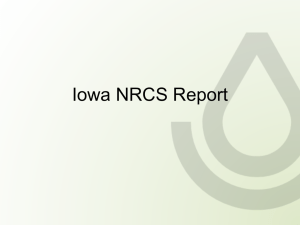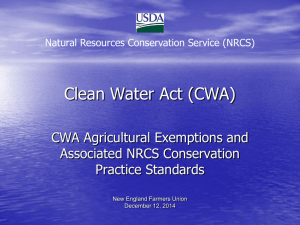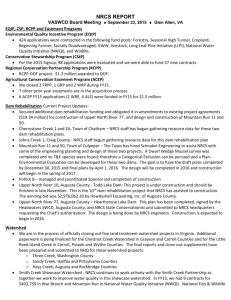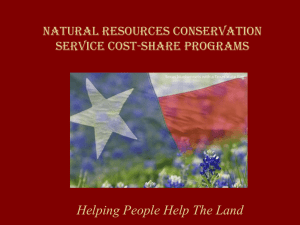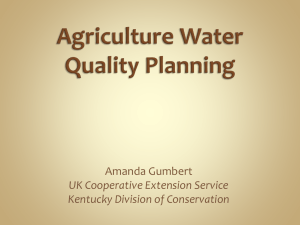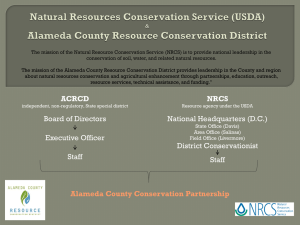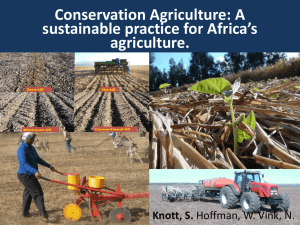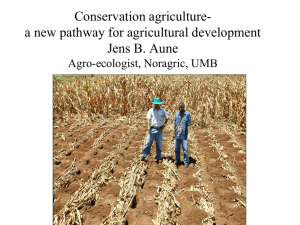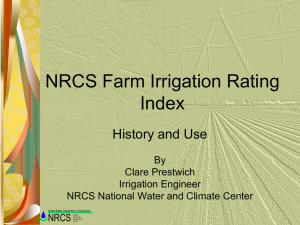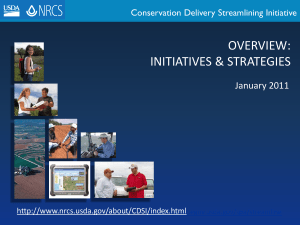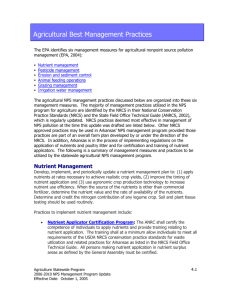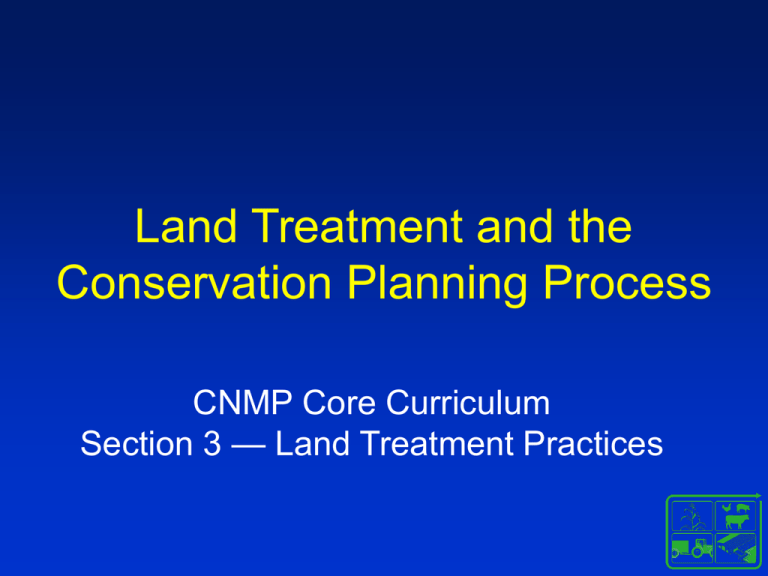
Land Treatment and the
Conservation Planning Process
CNMP Core Curriculum
Section 3 — Land Treatment Practices
CNMP Development
Core Training Curriculum
These course materials have been developed as a
cooperative effort between five land-grant universities
and The Natural Resources Conservation Service.
Copyright Information
Ames, Iowa 50011, (515) 294-4111.
Copyright © 1995-2006, Iowa State University
of Science and Technology. All rights reserved.
Objectives
• To gain an understanding of how Land
Treatment fits into the CNMP.
• To understand the concept of identifying
risks from land treatment and implementing
conservation practices to mitigate the risks.
• To gain an understanding of what the NRCS
planning process consists of and that it is
the preferred method of planning for natural
resource problems.
Required Materials
• NRCS, National Planning Procedures Handbook, Part
600.5, Part 600.3 Plan Format and Content, and Part
600.2, NRCS Planning Process
• Comprehensive Nutrient Management Planning Technical
Guidance
• NRCS Field Office Technical Guide, Section II
• Nitrate Leaching Index
• NRCS General Manual, Part 402, Policy for Nutrient
Management;
• Revised Universal Soil Loss Equation 2
• http://fargo.nserl.purdue.edu/rusle2_dataweb/RUSLE2_In
dex.htm
• National Agricultural Pesticide Risk Analysis (NAPRA),
http://www.wcc.nrcs.usda.gov/pestmgt/napra.html
• TechReg website, http://prs.sc.eaov.usda.qov
Supplemental Materials
• NRCS Field Office Technical Guide, Section
IV
• NRCS, National Planning Procedures
Handbook, Part 600.4 Planning
Fundamentals
• NRCS Field Office Technical Guide Section
IV, Conservation Practice Standards.
Purpose of Land Treatment
•
How does Land Treatment fit into the CNMP?
–
The land treatment section identifies the risks resulting from
spreading manure on the land.
Purpose of Land Treatment
• The land treatment section identifies conservation
practices that need to be used on the land to
mitigate the risks identified.
Purpose of Land Treatment
• Land treatment
plans are site
specific.
Walk over the land
and identify problem
areas.
Kneel down in
the field, chew on
a blade of grass
with the farmer
and discuss the
plan.
Purpose of Land Treatment
• The land treatment section
includes
– Review & assessment of all
land application sites
– Identification of risks
– Use tools such as P-index,
RUSLE2, N Leaching
Index, WEQ, to evaluate
risks
– Develop site specific
conservation plans to address
risks presented by land
treatment
The Planning Process
•
•
The 3 Phase, 9 Steps of the
Conservation Planning Process is
used by NRCS to develop land
treatment plans
The 9-step process consists of:
• Determine Objectives
1. Identify problem
2. Determine objectives
3. Inventory resources
4. Analyze resources
• Evaluate Alternatives
5. Formulate alternatives
6. Evaluate alternatives
7. Make decisions
The Planning Process
• Apply & Evaluate
8. Implement plan
9. Evaluate plan
(Includes monitoring
of progress and
reporting in NRCS
reporting system.)
Apply Planning Process to Land
Treatment
1. Identify the Problem
•
What Are the Risks
From Land
Application of
Manure?
– Consider the risks to
soil, water, air, plants,
animals & humans.
1. Identify the Problem
•
Soil
– Erosion
– From water & wind,
control erosion to
“T”
– Soil quality
1. Identify the Problem
• Water
– Surface &
groundwater
– Nutrients &
pathogens
1. Identify the Problem
•
Air
–
–
–
–
Gaseous emissions
Particulates
Greenhouse gases
Odor
1. Identify the Problem
• Animal health
– Identify animal health issues associated
with land application of manure
- Transmission of disease
- Protection of wildlife
1. Identify the Problem
• Human health
– Pathogens
– Heavy metals
– Nitrates in drinking water
2. Determine Objectives
•
Objectives That Must Be Met With the Land
Treatment Plan
– Farmer objectives
– Limit off-site impacts from land application of
manure
– Federal, state and local water quality rules
– Permitting requirements
– NRCS Quality Criteria for soil erosion and water
quality
-Field Office Technical Guide Section III
3. Inventory the Sites
• Sources of Info
–
–
–
–
–
Soil surveys
GIS data layers
Topo maps
Aerial photos
TMDLs
3. Inventory the Sites
•
Sources of Info
–
–
–
–
–
Geology maps
Watershed maps
Well head protection areas
Existing conservation plans
Existing nutrient management plans
3. Field Observations
•
•
Walk over each land application field
Identify problem areas
– Distance to surface waters
– Groundwater recharge areas
– Eroding areas
3. Field Observations
•
Identify problem
areas
–
–
–
–
Identify setbacks
required by state or
federal rules
How does runoff
leave the field?
Drainage ways
Subsurface drain
inlets
3. Field Observations
•
Farmer Interview
– Local knowledge
of the land
– Existing
conservation work
– Existing and past
manure application
practices
– Current equipment
limitations
– Soil tests
– Manure tests
4. Analyze Resources
•
With data collected,
need to analyze the
data to understand
the risks.
–
–
•
Some risks may be
obvious, such as direct
runoff into streams.
Other risks, such as
threats to ground
water, may be less
obvious.
Many assessment
tools are available to
help determine the
risks of land applying
nutrients.
4. Analyze Resources
• Nitrate leaching index
– Allows the user to compare
the potential for nitrate loss
on different soils
– Allows the user to
determine quantitatively
how much nitrate might
leave a site
– Section II of the FOTG
– Not available in all states
4. Analyze Resources
•
P Management
– Varies from state to state.
» P-Index
» P threshold levels
» Agronomic soil test P levels.
– P-Index reflects the potential for P
movement or loss from a field.
– The answer from the P-index
determines the maximum P
application rate and/or the
practices necessary to mitigate
the risks from P application.
4. Analyze Resources
• P Management
– P-indices consider source, transport
mechanisms by water and erosion,
soils, slope, proximity to water
bodies, and rate and timing of
manure applications.
– Refer to each state NRCS office to
determine the P-index used in the
state.
4. Analyze Resources
•
RUSLE2
– The latest version of the Universal
Soil Loss Equation developed by
ARS at the National Soil Erosion
Lab at Purdue.
– Windows-based.
– Calculates soil loss from sheet
and rill erosion from cropland.
– Has been implemented by NRCS
nationwide. Contact the local
NRCS office or the NRCS State
Agronomist in the state.
4. Analyze Resources
•
•
Wind Erosion Equation (WEQ)
– Used to calculate soil loss from wind erosion
– Only used on soils prone to wind erosion
– WEQ was first released in 1963
– Currently an EXCEL spreadsheet
– Follow this link for more information on the use of
the WEQ spreadsheet to calculate wind erosion:
http://www.nrcs.usda.gov/technical/ECS/agronomy/WEQGuidance.doc
– Contact the State Agronomist for assistance
4. Analyze Resources
• NAPRA (National Agricultural
Pesticide Risk Assessment)
– Can also be used for nutrient
loss risk assessment.
– Based on the GLEAMS
model.
– Determines a quantitative
amount for nutrient and
pesticide loss.
6. Formulate Alternatives
7. Evaluate Alternatives
•
•
Develop alternatives to address the risks and meet
the objectives identified in the first 4 steps.
Evaluate the alternatives with the farmer to develop
the best plan that can be implemented by the farmer.
7. Evaluate Alternatives
•
Put the plan on paper. The
plan should consist of:
– Aerial photos or maps
that identify each field
where land application will
take place.
– The location of all
practices that need to be
in place to address the
risks identified.
– A schedule of when &
where the practices will
be installed.
7. Evaluate Alternatives
• Put the plan on paper.
The plan should consist of
– A narrative describing
each practice and how
it should function
– O&M information that
the farmer should
follow to ensure that
the practices function
properly over time.
Apply and Evaluate
•
Evaluation of the plans include:
– The steps should be followed
after the plan is implemented.
– Make adjustments to the
plan to fit the changing
needs of the land and the
farm operation.
Apply and Evaluate
•
Reporting of progress on
the plan in the NRCS
reporting system
– TSPs are required to
report the results of their
work to NRCS.
– Check with the applicable
state for reporting
requirements and
methods.

